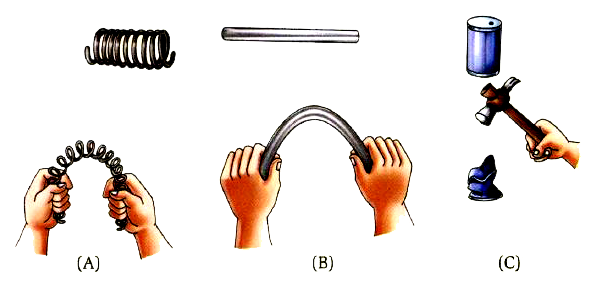List the different effects of force.
Step-by-Step Solution:
1. Understanding Force: Begin by defining what a force is. A force is a push or pull that can cause an object to move, stop, or change its motion.
2. Listing the Effects of Force:
- Effect 1: Stopping a Moving Object: A force can bring a moving object to a stop. For example, when you apply brakes to a bicycle, the force from the brakes stops the wheels from turning.
- Effect 2: Moving a Stationary Object: A force can cause a stationary object to start moving. For instance, pushing a heavy box can make it slide across the floor.
- Effect 3: Changing the Speed of a Moving Object: A force can increase or decrease the speed of an object that is already in motion. For example, when you kick a soccer ball, the force from your foot increases its speed.
- Effect 4: Changing the Direction of a Moving Object: A force can change the direction in which an object is moving. For example, when you steer a car, you are applying a force that changes its direction.
- Effect 5: Changing the Size and Shape of an Object: A force can also change the size or shape of an object. For example, when you squeeze a rubber ball, the force changes its shape.
3. Conclusion: Summarize the five effects of force: stopping a moving object, moving a stationary object, changing the speed of a moving object, changing the direction of a moving object, and changing the size and shape of an object.
---
- Effect 1: Stopping a Moving Object: A force can bring a moving object to a stop. For example, when you apply brakes to a bicycle, the force from the brakes stops the wheels from turning.
- Effect 2: Moving a Stationary Object: A force can cause a stationary object to start moving. For instance, pushing a heavy box can make it slide across the floor.
- Effect 3: Changing the Speed of a Moving Object: A force can increase or decrease the speed of an object that is already in motion. For example, when you kick a soccer ball, the force from your foot increases its speed.
- Effect 4: Changing the Direction of a Moving Object: A force can change the direction in which an object is moving. For example, when you steer a car, you are applying a force that changes its direction.
- Effect 5: Changing the Size and Shape of an Object: A force can also change the size or shape of an object. For example, when you squeeze a rubber ball, the force changes its shape.
Topper's Solved these Questions
- FORCEBOOK - ICSECHAPTER - FORCEEXERCISE - Exercises (Section II) Long answer questions.
4 Videos
- FORCEBOOK - ICSECHAPTER - FORCEEXERCISE - Picture Based Questions
2 Videos
- FORCEBOOK - ICSECHAPTER - FORCEEXERCISE - Exercises (Section II) Distinguish between the following
2 Videos
- ENERGY BOOK - ICSECHAPTER - ENERGY EXERCISE - Picture Based Questions
9 Videos
- LIGHTBOOK - ICSECHAPTER - LIGHTEXERCISE - Picture Based Questions
21 Videos
Similar Questions
List the different zones of an aquatic body.
View SolutionList the different types of pollination depending upon the source of pollen grain .
View SolutionList two different functions performed by pancreas in our body.
View SolutionList the different system of units.
View SolutionIn the following pictures , figure out what are the effects of the forces on different objects.

View SolutionList five different types of allergens.
View SolutionState two factors affecting the turning effect of a force.
View SolutionGive another name for the turning effect of force.
View SolutionList the different antibiotics & their source microbes
View SolutionDiscuss the effects of force with examples.
View Solution
